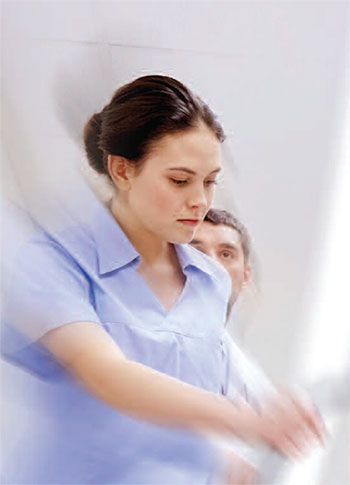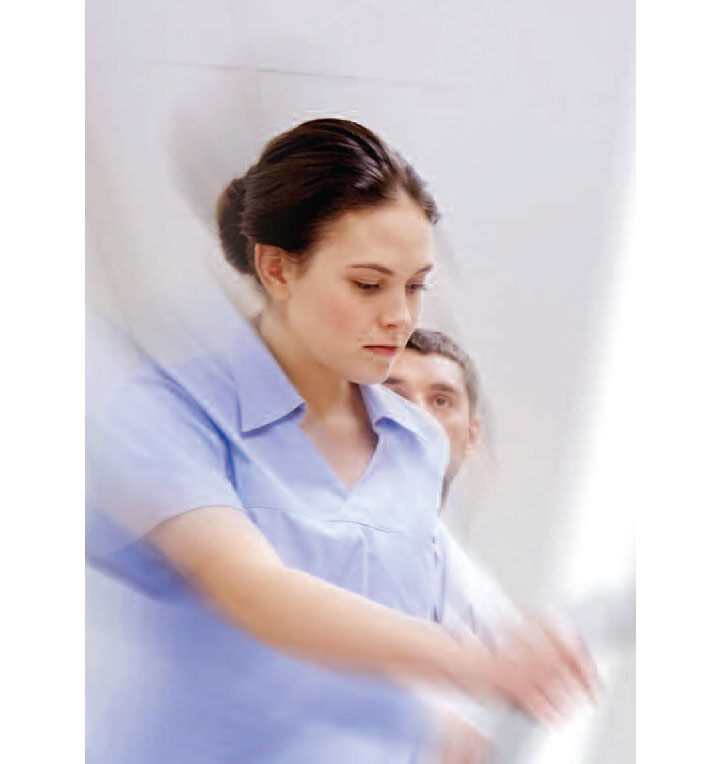Patient history, new symptoms, and assessment findings prompt a call for the rapid response team
Takeaways:
- Atrial fibrillation results from rapid electrical activity that arises from different ectopic foci.
- Definitive diagnosis of atrial fibrillation is made with a 12-lead ECG
- Pharmacologic treatment includes selective beta 1 adrenergic receptor blockers to decreases the automaticity of contractions.
By Felice Hefferan, MSN, RN
Robert Meyers, who’s 68 years old, receives a porcine mitral valve replacement without left atrial appendage. Four days later, he complains to you of a “fluttering feeling with chest discomfort and weakness.” His medical history includes hypertension and diabetes.
Assessment


On the scene
The RRT places Robert on 2 liters of oxygen by nasal cannula. A 12-lead electrocardiogram (ECG) reveals atrial fibrillation with a ventricular HR of 150 bpm. Orders from the RRT physician include a 5 mg I.V. bolus of metoprolol administered over 2 minutes, a saline infusion over 8 hours, and a continuous heparin infusion. A standing order is placed for oral metoprolol 50 mg every 12 hours with parameters to withhold the medication if Robert’s HR is below 50 bpm and his BP is less than 100/60 mm Hg. The RRT’s goal is to control Robert’s ventricular rate and heart rhythm and prevent stroke.
Outcome
After the I.V. metoprolol and the saline infusion, Robert’s HR is 100 bpm (but the atrial fibrillation continues), his BP is 110/60 mm Hg, and he reports no further chest discomfort. The next day, Robert converts to sinus rhythm. He remains on a heparin infusion with the intent to place him on warfarin for 3 to 6 months along with 81 mg per day of aspirin. A postdischarge consult is scheduled with the electrophysiologist.
Education
Atrial fibrillation, a common arrhythmia in patients after valve surgery even when the patient has no history of arrhythmias, results from rapid electrical activity that arises from different ectopic foci. Uncoordinated atrial pumping and ineffective contraction can lead to blood stagnation in the atria because it can’t be fully emptied, placing patients at risk for thrombus and stroke. Other causes of atrial fibrillation after cardiac surgery include coronary heart disease, left ventricular hypertrophy, pulmonary disease, and left-side heart failure.
Management
Definitive diagnosis of atrial fibrillation is made with a 12-lead ECG. Pharmacologic treatment includes selective beta 1 adrenergic receptor blockers to decrease the automaticity of contractions, thereby controlling the HR, although they typically don’t convert the abnormal heart rhythm. When beta blockers are contraindicated in patients with severe reactive airway disease, calcium channel blockers are used to inhibit calcium from entering cells, resulting in controlled HR. Other pharmacologic treatments include amiodarone for patients with a decreased ejection fraction and antiarrhythmic agents to restore normal heart rhythm. When pharmacologic agents aren’t effective, other options include ablation and cardioversion.
Follow up
Robert returns to his cardiologist for his annual checkup with no further complaints of fluttering, chest discomfort, or weakness. A routine ECG confirms a sinus rhythm resulting from pharmacologic treatment and normal left ventricular function. Robert remains symptom free.
Felice Hefferan is a cardiac rehab nurse at Paoli Hospital in Paoli, Pennsylvania.
Selected references
Frankel G, Kamrul R, Kosar L, Jensen B. Rate versus rhythm control in atrial fibrillation. Can Fam Physician. 2013;59(2):161-8.
Frendi G, Sodickson AC, Chung MK, et al. 2014 AATS guidelines for the prevention and management of perioperative atrial fibrillation and flutter for thoracic surgical procedures. The J Thorac Cardiovasc Surg. 2014;148(3):772-91.
January CT, Wann LS, Alpert JS, et al. 2014 AHA/ACC/HRS guidelines for the management of patients with atrial fibrillation: A report of the American College of Cardiology/American Heart Association Task Force on Practice Guidelines and the Heart Rhythm Society. J Am Coll Cardiol. 2014;64(21):e1-e76.
Linden B. Diagnosis and management of atrial fibrillation: The latest NICE guidance. Brit J Card Nurs. 2014;9(8):372-3.
Raiten J, Patel PA, Gutsche J. Management of postoperative atrial fibrillation in cardiac surgery patients. Semin Cardiothorac Vasc Anesth. 2015;19(2):122-9.
ant2-Rapid Response-118



















1 Comment.
My dad was fighting atrial fibrillation for eight years. he was on Coumadin. It has been a losing battle for us, and the last few years have been especially disappointing. It started when he was 60 years old.They did several tests to confirm it. They did echo, cardiac stress test, dobutamine stress test, x-ray, and EKG. My dad is was taking Coumadin/Warfarin, Digoxin, Cozaar, and Metoprolol. With Coumadin/Warfarin which didn’t work perfectly for him, some days it’s all it can do to just show up. However, we didn’t give up. Until we found totalcureherbsfoundation.com which we purchase atrial fibrillation herbal remedy that cured him totally from atrial fibrillation, my dad thyroid is normal again, and the shortness of breath is gone. My dad blood pressure is normal now, he feel like a new person due to the help of the herbal formula.